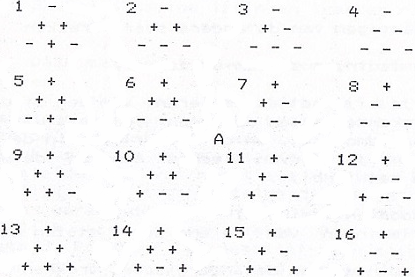At this page I am still trying to construct gravitation as net force of the other forces. This page is a previous attempt from the years 1990 - 1992.
Between 3 kinds of charge
We start again with a cloud of n positive and n negative electric charges in a homogeneous mix. The previous pages show an attractive net force being present in such a cloud of charges, which is an asymmetry. The asymmetry doesn't follow from the law of Coulomb nor from the definition of positive and negative electric charge. This asymmetry is caused by the laws that rule attraction and repulsion between electric charges. These laws are quite asymmetric.
1) Equal charges repel each other;
2) Opposite charges attract each other.
These two laws can be found in the law of Coulomb
F = Q1 * Q2 / 4 * π * ε0 * r
in the way the signs of the charges multiply:
+ * + = +
+ * - = -
- * + = -
- * - = +
wherein the first sign in the left side of the equation is the sign of charge Q1 and the second sign is from charge Q2. These multiplication rules are asymmetric too. That is, if there is a symmety I don't see it.
(More symmetrical would be + * + = +, - * - = -, + * - = +, - * + = - . But then, why not + * - = - and - * + = + ? So even this is not completely symmetric, aside from that it doesn't apply to our universe.)
F = force between charges Q1 and Q2, ε0 = dielectric constant of the vacuum
An extension from this set of laws is:
3) Equal charges attract each other
4) Opposite charges repulse each other
This set would yield a repulsive net force.
The net charge of the system is zero (the system is electrically neutral). The net force in the system is NOT zero. The sum of two equal but opposite things is zero, that is the starting axiom. If the outcome is not zero then OR the things are not equal OR the things are not opposite. For sure they are equal. So they are not opposite. Positive and negative are just two kind of charges and very well there can be added another kind. Or more kinds.
Considerations about the net force inspired to more laws between the electric charges than the well-known ones, and also that there could be more than two kind of charges.
An overview of 3, 2 and 1 kind of charge.
Suppose there are 3 kinds of charge. Set each kind of charge at a corner point of a equilateral triangle.
A +
at a corner point means the charges there attract each other. A -
at a corner point means the charges of that kind repel each other. A +
at the midst of a side of a triangle means the kind of charges at both ends of that side attract each other. A -
at the midst of a side means the charges connected by that side do repel each other.


Two kinds of charge, the well-known situation for electric charges. From the triangles only one side is left.

Last but not least, one kind of charge:
![]()

A
are the points of symmetry in the schemes. When in one set of laws, e.g. nr 17, the plus- and minus-signs are turned to their opposite, then the point mirror images with respect to A are the same, in this case 17 and 22 have become equal.
There are 16 + 4 = 20 possible sets with 3 kinds of charge. Mark set 2 and set 17 both resemble well-known situation between positive and negative electric charges. Sets 13, 19 and 24 resemble actual situation in gravitation.
With a lot of help from Klaas van Aarsen (Leiden, 1990) I wrote a simulation program in PASCAL that shows the threedimensional orbits of (not too much) particles with arbitrary mass, arbitrary number of kinds of charges, arbitrary number of charges, arbitrary charge size, arbitrary starting positions and starting velocities and an arbitrary set of laws governing the attraction or repulsion within and between the kinds of charges. Klaas implemented the Runga Kutta method.
There are no new conclusions or it should be that configurations with completely different force laws and kinds of charges do not essentially differ from evolvement in well-known situations. The kind of charges and their relative laws are hardly or not visible from the outside.
Defining antiparticles is no longer unequivocal. However, one can always create an anti situation
by everywhere changing the +
sign by a -
sign and vice versa.
One can imagine the quantum fluctuations of the vacuum to consist of superpositions of all possible kinds of charges and all possible laws of attraction and repulsion between them. No, I did not investigate this any further.